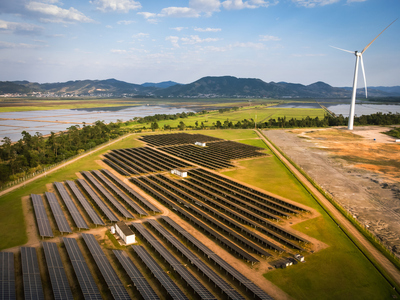Discover the critical challenges and promising future of the offshore wind sector, including insights on supply chain coordination, investor confidence, and talent acquisition, and understand why a strategic recalibration is essential for achieving long-term success.
“The energy trilemma—affordability, sustainability, and security—remains the framework shaping policy decisions. But the balance has shifted. Amid economic uncertainty, affordability and security have overtaken decarbonisation as political imperatives. In this context, policymakers are increasingly reluctant to back offshore wind at scale—especially when cheaper and faster alternatives promise more immediate returns.”
Prasoon Kumar
1. The Offshore Wind Paradox
On paper, offshore wind is the MVP of clean energy. It ticks every box: big capacity, big jobs, big impact. And yet, the sector is wobbling under its own weight. Margins are down. Projects are delayed. Valuations have taken a hit. So, what's going on?
Unlike solar and battery storage—where costs fell like dominoes thanks to tech gains and steady policy—offshore wind is facing a tougher curve. Sure, the LCOE dropped in the early years. But lately? Not so much.
Industry veterans were right to caution that offshore wind would not mirror the development curve of solar or onshore wind. Each technology follows a unique trajectory, shaped not only by its technical characteristics but also by the strength and readiness of the ecosystem that surrounds it.
Offshore wind is a heavy industrial sector with complex logistics and infrastructure, and a massive dependency on ports and grid infrastructure, hence on government policy. But the cohesion of that ecosystem has faltered—exposing weak links in coordination, investment, and delivery.
1.1 Supply Chain: Big Turbines, Bigger Headaches
The supply chain isn’t broken—but it’s undeniably buckling under the weight of offshore wind’s ambitions.
Over the past two decades, turbine capacity has ballooned from 2MW to 15MW, with 235-metre blades spinning far offshore in deeper waters. That kind of scale demands more sophisticated infrastructure, tighter logistical choreography, and far heftier upfront capital. But supply chain investment? Still playing catch-up.
As Claus Østergaard points out, “Many OEM suppliers were prepared to scale up in 2024 to 2025, but that did not happen because the value chain hasn’t been synchronised.” He underscores that while the sector attracts significant capital, this hasn’t translated into timely deployment—largely because “the whole value chain was not working together.” He adds: “Many players realise they don’t even have enough vessels and raw material for all those gigawatts.”
"Two things still need to be proven: that we can install 15 MW wind turbines as efficiently as we used to install 10 MW turbines offshore, and that offshore wind can be profitable by running assets and selling power at a reasonable value, not just through balance sheet operations and farming down," comments Philippe Kavafyan.
Key components remain constrained. Specialised installation vessels are booked out or ageing. Ports are stretched. And thanks to post-COVID inflation and commodity price volatility, material and labour costs are only now returning to predictable.
This mismatch—between rapid technological growth and lagging industrial capacity—has throttled the kind of cost reductions seen in solar or onshore wind. Innovation alone isn’t enough. Without a resilient, scaled-up supply base behind it, even the most advanced turbine designs struggle to deliver financial viability at scale.
1.2 Strong Fundamentals, Weak Sentiment
Ironically, wind remains one of the most technically robust forms of renewable energy. With a CUF of 50–55%—more than double that of solar—it was meant to be the backbone of a stable, renewables-based grid. The promise was elegant: solar by day, offshore wind by night, phasing out fossil fuels without sacrificing reliability.
That promise still holds. The long-term fundamentals haven’t changed. What has changed is sentiment. The sector has hit a rough patch, battered by inflation, interest rate hikes, supply chain disruptions, and geopolitical aftershocks. Project margins have thinned, valuations have slumped, and investors—understandably—are asking harder questions.
Offshore wind hasn’t lost its strategic value. But it is losing the benefit of the doubt.

1.3 The New Competition
Offshore wind is no longer just competing with fossil fuels—it is now contending with the full breadth of the global energy system. Gas-fired power, still positioned as a ‘transition fuel,’ continues to benefit from geopolitical tailwinds. In the wake of Russia’s invasion of Ukraine, the rapid influx of LNG from the United States has filled the gap in European supply, reinforcing gas’s short-term appeal.
In many markets, particularly in the US and parts of Asia, offshore wind struggles to match the low cost and swift deployment of gas. This disparity has been magnified by the macroeconomic environment: rising interest rates and persistent inflation have increased capital costs across the board, but long-duration, infrastructure-heavy projects like offshore wind have been hit hardest.
As Prasoon Kumar points out, “The energy trilemma—affordability, sustainability, and security—remains the framework shaping policy decisions. But the balance has shifted. Amid economic uncertainty, affordability and security have overtaken decarbonisation as political imperatives. In this context, policymakers are increasingly reluctant to back offshore wind at scale—especially when cheaper and faster alternatives promise more immediate returns.”
1.4 Capital Constraints and Investor Caution
Offshore wind remains a capital-intensive, longer-term proposition. It requires either sustained public-sector underwriting or private investors with the appetite—and patience—for long-dated returns in a volatile policy environment. At present, both are in increasingly short supply.
- IOCs and Utilities
- While European utilities such as RWE, Engie, and SSE continue to back offshore wind, their capital is being stretched across competing priorities—from nuclear to green hydrogen. International oil companies, once vocal in their enthusiasm, have begun to retreat. Several have scaled back or exited entirely, driven by shifting internal strategies and a tougher macroeconomic climate. With higher interest rates and elevated opportunity costs, offshore wind has lost some of its shine.
- Technology vs. Economics
- Technological maturity—especially in fixed-bottom offshore wind—has not yet translated into economic ease. Floating wind, often touted as the next frontier, remains far from commercial viability. The technical risks, coupled with unclear cost trajectories, are proving too steep for many investors.
- Private Capital’s Dilemma
- Private equity and infrastructure funds, buoyed by record levels of dry powder and ESG mandates, have shown growing interest in offshore wind. But with returns often capped, many remain hesitant. The problem is not capital availability, but the misalignment between risk, return, and regulatory certainty. Unclear auction designs, volatile power prices, and opaque permitting processes add layers of complexity that investors cannot easily price.
- “Right now, private equity is a big driver of offshore wind investment,” says Prasoon Kumar. “But with returns hovering around single digits, very few investors are stepping in—despite all the dry powder sitting idle.”
- Public Sector Pullback
- Offshore wind has always leaned heavily on state support—not just through subsidies in its initial phase, but via investments in grid infrastructure, port upgrades, and transmission planning. That support has wavered. In key markets, grid delays, regulatory inertia, and a failure to adjust auction frameworks for inflation have dented project economics. Undersubscribed tenders and cancellations are becoming more common. Without clearer policy signals and public co-investment, private capital will remain cautious. The future of offshore wind depends as much on political will as on market fundamentals—and that will has of late, been uneven at best.





